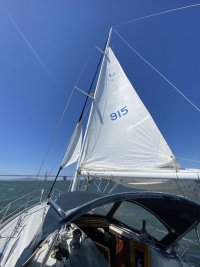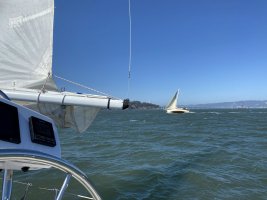Alan Gomes
Sustaining Partner
My 135% is not brand new but is still in good shape. I've not tried sailing with no main and a partially furled jib; I've only done it fully unfurled. The boat goes to weather quite well on 135% alone, whether in light or heavy air.The 25+ was a 1980 with the 4'11". My 135 was newer but had a lot more miles under it. The sail maker I took it to said it was way beyond repair and asked me to bring in all my other sails so he could advise on what I should do. He said the 110 was in perfect shape, so I had him put a luff tape and UV cover and I used that for the last 4 years. It was great for single handing and I didn't notice any loss in performance. We did use it alone when going down wind with good results, but anytime I tried to go above a beam reach I had some issues with it. The main problems were a neutral helm to lee helm and getting the boat to go through the tack.
Maybe my experience is a combination of the 135 being blown out and the 110 placing the CE too far forward under Jib alone. Or it could be the 25+ was my first boat. I had lazy jacks, a new traveler, adjustable back stay, boom vang, and a cunnignham on the 25 which made using the main easy and effective. I didn't really have any reason to experiment with jib alone after making all the improvements to the mainsail handling so . It would be interesting to go back and sail it again to see if it was a perceived issue or an actual issue with this new found perspective.
I don't typically sail with jib alone but have done so a number of times when I just didn't feel like going to the trouble to remove the mainsail cover and raise the main. I have been surprised at how well the boat sails. My experience is consistent with what others have reported about balance and also a good turn of speed when the wind is up. When the wind really kicks up I find that the boat also balances well with a double-reefed main and a partially furled jib (110%?). On this fractional rig even the full 135% is not exceptionally large.
I think if I were out in the San Pedro channel coming back from Isthmus cove in 30+ kts. (which has happened to me on previous boats), I'd probably strike the main entirely and just go with the jib, based on my experience with it to this point.




